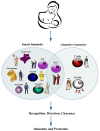Innate Immunity of Neonates and Infants
- PMID: 30105028
- PMCID: PMC6077196
- DOI: 10.3389/fimmu.2018.01759
Innate Immunity of Neonates and Infants
Abstract
Many important events occur at birth. The fetus is suddenly removed from a protected intra-uterine environment that is aquatic, warm, and nearly sterile, to the dry, cold external world laden with microbes. To survive, the neonate must interact with many organisms, making use of some, while vigorously defending against the others like a nation conducting trade with friendly countries and guarding against hostile ones from invading it, waging wars if necessary. Although, the neonatal immune system is plastic, however, it is highly tolerant which is due to both the fetal development during gestation as well as significant sudden changes in fetal environment and enormous exposure to the new antigens and intestinal bacteria and their products. This "quiescent mode" of innate immune system is part of a highly regulated process to fulfill all requirements of multi-layered process of early life, implemented effectively through the cells of innate immune system. While, most of the neonatal innate immune cells (e.g., neutrophils and monocytes) present contained activity and lower frequencies compared to their adult counterparts, innate lymphoid cells (ILCs), a distinct cellular component of innate immunity, show higher level of activity and presence during period of infancy compared to later stages of life and adulthood, which may suggest a role for ILCs in variable susceptibility to certain conditions during life time. In this review, while we focus on the characteristics and status of ILCs in neonatal immune system, we also draw an analogy from a national defense perspective because of the great similarities between that and the immune system by providing the known biological counterparts of all five core operational elements, the five Ds of defense, detection, discrimination, deployment, destruction, and de-escalation, with special focus on innate immunity, maternal support, and influence during the neonatal and infancy periods.
Keywords: innate immunity; innate lymphoid cell; microbiome; milk; neonate immunity.
Figures





References
Publication types
MeSH terms
Substances
LinkOut - more resources
Full Text Sources
Other Literature Sources

